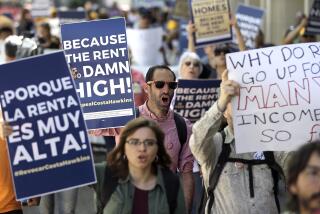Santa Monica Renters Face Sharp Rise in Evictions
- Share via
Hundreds of evictions loom in Santa Monica as an increasing number of landlords put the city on notice that they intend to get out of the rental business.
The threat of evictions comes in the wake of Santa Monica’s Rent Control Board losing ground in its long fight against the state’s Ellis Act, which bars cities from forcing landlords to stay in the rental business.
Rent board Chairwoman Susan Packer Davis is hoping to use the eviction threat to rally support for the board’s much-criticized inclusionary housing program, which would allow landlords to significantly raise rents by as much as $900 on some units if an equal number of units are set aside at lower rents, as low as $266 a month, for poor people.
“This is the most concrete evidence of why we need this program,” Davis said. “For us to ignore this would be completely irresponsible. I have sort of resisted that notion for several months. But I now realize that it’s the only solution we have. Everything else has been taken away from us.”
The program has been criticized by landlords--who say the financial incentives fall short--and by tenants, who say it gives landlords too much.
The board is expected to make its final decision on the inclusionary housing program after public hearings this month and in September.
As of last Wednesday the owners of 113 buildings, representing 595 rental units, had filed notices of intent to evict their tenants. That is a 19.9% increase from figures in April, when notices for 88 buildings accounting for 496 units were on file.
In September, 1988, owners of 55 buildings with 337 units had filed notices of intent to evict tenants under the Ellis Act, according to Santa Monica Rent Control Board administrator Mary Anne Yurkonis.
Yurkonis said she did not know how many of the 113 buildings have already been demolished, but she said all could be torn down eventually.
“The thing that is so disturbing about Ellis is that these rental units are removed from the housing market,” Yurkonis said. “It’s hard to get affordable housing back once it has been demolished.”
Early this month, Santa Monica Superior Court Judge Jack M. Newman dismissed two cases filed by the board aimed at stopping a group of owners from occupying apartment buildings after they evicted the tenants under the Ellis Act.
Newman ruled that the rent board did not have authority in the matter since no rent control law was involved, and that at the time of filing there was no law forbidding the group of owners from moving into the buildings.
“I believe the lawsuit was filed frivolously to begin with,” said attorney Gordon P. Gitlen, who represented the owners. “To get permission to live on your own property is ridiculous. The city has wasted a tremendous amount of money on this lawsuit. Hopefully, the needless expense will now cease.”
The rent board, however, has decided to appeal within a month, said rent board staff attorney Ralph Goldsen.
Losing End
Indeed, the board has been mostly on the losing end of court decisions challenging the Ellis Act, which grew out of a lawsuit brought by landlord Jerome J. Nash after the city refused to allow him to demolish a six-unit apartment building. Nash went to court claiming that the city’s rent control law violated his right to go out of business. Nash won in Superior Court, but the decision was reversed by the state Supreme Court. In March, 1985, the U.S. Supreme Court refused to hear the case.
That prompted then-state Sen. Jim Ellis (R-El Cajon) to introduce a bill that would prevent local governments from forcing landlords to stay in the rental business. The law became effective July 1, 1986.
In response, the city of Santa Monica passed an ordinance requiring landlords to pay evicted tenants relocation benefits of up to $4,000, depending on the size of the unit and whether the tenant is elderly, disabled or has children.
In September, 1986, the city launched its first challenge against the Ellis Act by suing landlord Henry Yarmark, who was trying to evict 35 tenants from five buildings. The city claimed the law intruded on its local authority, as granted by the state Constitution.
A Superior Court upheld a landlord’s right to evict tenants under the Ellis Act and a state appellate court backed that decision. The state Supreme Court last October refused to hear the city’s appeal.
In a related case in March, 1989, the state Supreme Court refused to hear the city’s appeal of a lower court ruling that landlords do not have to obtain a removal permit from the Rent Control Board to get out of the rental business under the Ellis Act.
Since those decisions, the City Council adopted an ordinance that applies local land-use controls to units removed under Ellis and converted to owner-occupied housing.
Meanwhile, Davis is concerned that while the debate continues, more rental units will be lost under the Ellis Act.
“I just want to put (the inclusionary housing program) in place and see what happens.” Davis said. If the board waits too long, she said, “there won’t be any need for rent control because there won’t be any buildings.”
More to Read
Sign up for Essential California
The most important California stories and recommendations in your inbox every morning.
You may occasionally receive promotional content from the Los Angeles Times.






